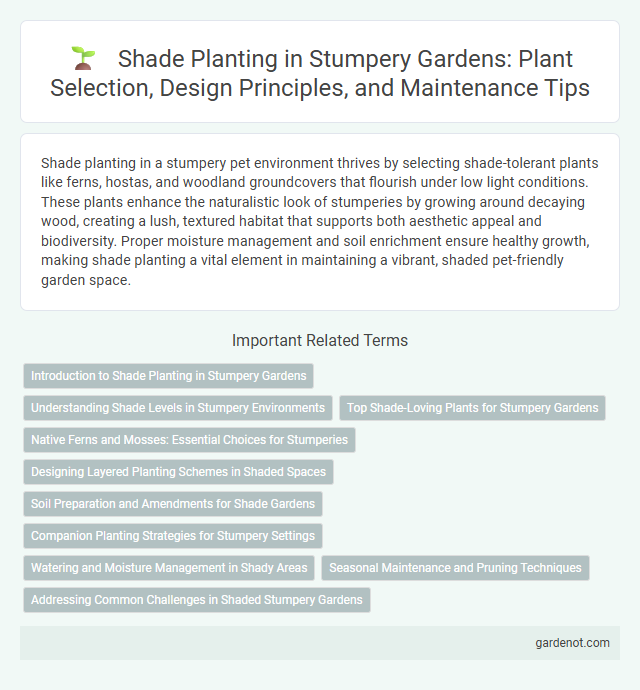Shade planting in a stumpery pet environment thrives by selecting shade-tolerant plants like ferns, hostas, and woodland groundcovers that flourish under low light conditions. These plants enhance the naturalistic look of stumperies by growing around decaying wood, creating a lush, textured habitat that supports both aesthetic appeal and biodiversity. Proper moisture management and soil enrichment ensure healthy growth, making shade planting a vital element in maintaining a vibrant, shaded pet-friendly garden space.
Introduction to Shade Planting in Stumpery Gardens
Shade planting in stumpery gardens utilizes plants adapted to low-light conditions, such as ferns, hostas, and woodland wildflowers, to enhance the natural, rustic aesthetic created by tree stumps and logs. These shade-tolerant species thrive in the cool, damp environment of stumperies, promoting biodiversity and creating microhabitats for native wildlife. Strategic placement of shade plants around decaying wood elements not only highlights textural contrasts but also supports soil health and moisture retention essential for sustainable garden design.
Understanding Shade Levels in Stumpery Environments
Shade planting in stumpery environments requires accurate assessment of varying shade levels created by dense tree trunks and decaying wood structures. Understanding light intensity gradients--from deep shade to dappled sunlight--enables selection of shade-tolerant plants like ferns, hostas, and hellebores that thrive in low-light conditions. Effective shade level evaluation ensures optimal plant growth, biodiversity, and aesthetic balance within the stumpery garden.
Top Shade-Loving Plants for Stumpery Gardens
Hostas thrive in stumpery gardens with their lush foliage and tolerance for deep shade, making them ideal for creating texture and color contrast. Ferns, such as the Japanese Painted Fern and Lady Fern, excel in shaded environments and enhance stumpery with their delicate fronds. Heucheras provide vibrant foliage in various colors, adding visual interest while flourishing in low-light conditions typical of stumpery setups.
Native Ferns and Mosses: Essential Choices for Stumperies
Native ferns such as the Christmas fern (Polystichum acrostichoides) and maidenhair fern (Adiantum pedatum) thrive in the shaded, humid environments of stumperies, providing lush, textured foliage. Moss species including sheet moss (Hypnum spp.) and haircap moss (Polytrichum spp.) create dense, green carpets that retain moisture and enhance the woodland aesthetic. These shade-loving plants are essential for stumperies due to their adaptability, low maintenance, and natural integration with decomposing wood structures.
Designing Layered Planting Schemes in Shaded Spaces
Layered planting schemes in shaded stumperies emphasize combining diverse foliage textures and heights to maximize visual interest and plant health. Utilizing shade-tolerant species such as ferns, hostas, and hellebores creates depth and seasonal variation within the shaded microenvironment. Strategic planting of ground covers beneath mid-height shrubs and taller tree stumps enhances moisture retention and optimizes light distribution in shaded garden areas.
Soil Preparation and Amendments for Shade Gardens
Soil preparation for shade gardens requires improving drainage and increasing organic matter to support shade-loving plants like ferns and hostas. Incorporating compost, leaf mold, or well-rotted manure enhances soil structure and nutrient content, fostering healthy root development in low-light conditions. Testing soil pH and adjusting with lime or sulfur ensures optimal nutrient availability for plants adapted to shaded environments.
Companion Planting Strategies for Stumpery Settings
Shade planting in stumpery settings thrives through strategic companion planting, combining ferns, hostas, and astilbes to enhance moisture retention and soil fertility. Incorporating shade-tolerant groundcovers like epimedium and lamium helps suppress weeds and maintain humidity, creating a balanced microclimate. Utilizing mycorrhizal fungi with shade-loving plants improves nutrient uptake, supporting healthy growth in low-light, woody environments.
Watering and Moisture Management in Shady Areas
Shade-loving plants in stumperies require consistent moisture to thrive, as shaded areas often have slower evaporation rates but can also retain dampness that promotes root rot. Watering should be adjusted to maintain evenly moist soil, avoiding both waterlogging and dryness by monitoring soil moisture levels regularly. Incorporating organic mulch helps regulate soil moisture and improve drainage in these low-light environments.
Seasonal Maintenance and Pruning Techniques
Shade planting in stumperies requires seasonal maintenance focused on managing moisture levels and removing debris to prevent fungal growth. Pruning techniques involve selective shaping and thinning of shade-loving plants like ferns and hostas to enhance airflow and promote healthy growth. Regular removal of dead or damaged foliage during late winter or early spring supports robust plant development and maintains the aesthetic appeal of the stumpery.
Addressing Common Challenges in Shaded Stumpery Gardens
Shade planting in stumpery gardens often faces challenges such as limited sunlight and poor soil drainage, requiring careful selection of shade-tolerant species like ferns, hostas, and astilbes. Enhancing soil quality with organic matter improves moisture retention and supports healthy root development in shaded conditions. Strategic plant layering maximizes available light and air circulation, reducing fungal diseases and promoting a lush, thriving stumpery garden.
Shade planting Infographic

 gardenot.com
gardenot.com